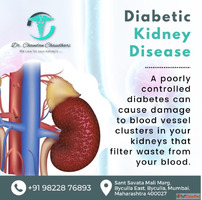No1 Cardiothoracic Vascular Disease Surgery in Mumbai
08/07/2024 Hospitals, Clinics
Price: 4.00 ₹
Description
Vascular disease encompasses a range of conditions that affect the blood vessels, compromising blood flow to various parts of the body. Vascular disease refers to any condition that affects the blood vessels, including arteries, veins, and capillaries. These diseases disrupt normal blood flow, leading to potential complications in the affected organs or tissues. Vascular disease can range from relatively benign conditions to life-threatening disorders.
Causes of Vascular Disease
Vascular disease can be caused by a combination of genetic factors, lifestyle choices,and other medical conditions. Common causes include:
Atherosclerosis: The buildup of fatty plaques within the arterial walls can narrow and harden the arteries, reducing blood flow.
Diabetes: Uncontrolled diabetes can damage blood vessels, leading to poor circulation and an increased risk of vascular complications.
High Blood Pressure: Hypertension puts strain on blood vessel walls, increasing the risk of vessel damage and dysfunction.
Smoking: Smoking damages blood vessel walls and accelerates the development of atherosclerosis.
Obesity: Excess weight can contribute to various vascular conditions, including atherosclerosis and venous insufficiency.
Family History: A family history of vascular disease can increase an individual's susceptibility to developing similar conditions.
Types of Vascular Disease
A. Peripheral Artery Disease (PAD): PAD occurs when arteries outside the heart, usually in the legs, become narrowed or blocked, leading to reduced blood flow and leg pain.
B. Aortic Aneurysm: A weakened area in the aorta (the main artery) can bulge and, if left untreated, rupture, causing life-threatening bleeding.
C. Deep Vein Thrombosis (DVT): DVT is the formation of blood clots in deep veins, typically in the legs, which can break loose and travel to the lungs, causing a pulmonary embolism.
D. Varicose Veins: Varicose veins are swollen, twisted veins that often appear in the legs and can cause discomfort and cosmetic concerns.
E. Carotid Artery Disease: Narrowing or blockage of the carotid arteries, which supply blood to the brain, can increase the risk of stroke.
Symptoms of Vascular Disease
The symptoms of vascular disease can vary depending on the type and location of the condition. Common symptoms include:
– Leg pain or cramping during physical activity (PAD)
– Cold or discolored extremities (PAD)
– Abdominal or back pain (aortic aneurysm)
– Swelling, pain, or redness in the legs (DVT)
– Bulging and twisted veins (varicose veins)
– Sudden weakness or numbness on one side of the body (carotid artery disease)
Risk Factors for Vascular Disease
Several factors can increase the risk of developing vascular disease, including:
– Age: Vascular disease becomes more prevalent with advancing age.
– Sedentary Lifestyle: Lack of physical activity can contribute to atherosclerosis and other vascular issues.
– Unhealthy Diet: A diet high in saturated fats, cholesterol, and sodium can promote atherosclerosis.
– Diabetes and Hypertension: These conditions increase the risk of vascular complications.
– Smoking and Alcohol: Tobacco and excessive alcohol consumption can damage blood vessels.
Treatment Options for Vascular Disease
Treatment for vascular disease depends on the specific condition and its severity. Common
treatment options include:
Lifestyle Changes: Adopting a healthy lifestyle, including regular exercise, a balanced diet, and smoking cessation, can improve vascular health.
Medications: Medications may be prescribed to manage risk factors, reduce blood pressure, or prevent blood clots.
Endovascular Procedures: Minimally invasive procedures, such as angioplasty and stent placement, can open narrowed or blocked blood vessels.
Surgical Interventions: Surgical procedures may be required for complex cases, such as aortic aneurysm repair or carotid endarterectomy.
Compression Therapy: Compression stockings can relieve symptoms of varicose veins and promote better blood flow in the legs.
Vascular disease encompasses a range of conditions affecting blood vessels, and it can significantly impact an individual's health and well-being. Early diagnosis and appropriate management are crucial in preventing complications and improving outcomes. Adopting a healthy lifestyle, managing risk factors, and seeking medical attention for any concerning symptoms are essential steps in maintaining optimal vascular health.





More Details